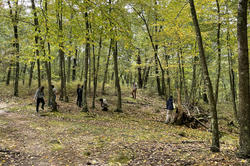Mycelium as Mode generates individual research projects exploring everything from decomposition to symbiosis to the containment of plastic waste.
Grad Students at RISD Discover, Invent and Repurpose Creative Camouflage Strategies

How can artists use camouflage to critique social and political systems and navigate the complexities of identity? What are the potential pitfalls and advantages of visibility and invisibility? A graduate-level Digital + Media course called Camouflage as Praxis challenges students to explore these and related questions and create work reflecting on legibility and illegibility.
“I tend to teach courses that are broad in terms of media but conceptually specific,” says Falaks Vasa, the multidisciplinary artist teaching the class. “We’re thinking about camouflage’s many forms—in nature, fashion, the military—but also in much broader ways, considering how it relates to the politics of representation and how we can intentionally deploy it.”
One classroom discussion centered on the sense of touch and the concept of skin, which Vasa describes as a kind of “surface camouflage. How do you think about touch in the digital space?” they asked the students. “If a stranger were to touch your work, what would you want it to feel like?”


The class discussed a wide range of artists who have explored themes of invisibility and the element of surprise to critique societal norms and and challenge notions of identity. Austrian artist VALIE EXPORT created the performance piece Tapp und Tastkino (Tap and Touch Cinema) in the late-1960s, making her body (clad in a cardboard box) the subject of a piece about societal norms, feminism and alienation. They also viewed conceptual pieces by satirical Italian artist Maurizio Cattelan and New Jersey-based video artist Sondra Perry, always through the lens of camouflage.
“I want to push you to take more risks with your own work for the rest of the semester,” Vasa told the class. “Get deeper into the work you’re making, try things you haven’t tried before and don’t be afraid to fail. Failing is when new ideas appear.”


Vasa’s teaching style is a democratic one, and each class begins with one of the students leading a skill-share in which they introduce the group to a new technique. Graphic designer Avrie Allen MFA 26 GD led a session on using fractals and displacement maps in Adobe After Effects (see top photo) and finding new ways of glitching/distorting videos. The idea was spawned by a classroom discussion about things that occupy multiple positions at the same time.
Anissa Pjetri MA 24 GAC focused on the concept of emotional realness in the context of camouflage. She divided the class in two, provided each group with a large sheet of acetate and colored markers and instructed the groups to map out systems of collaboration and kinship and instances in which we hide in order to survive.
Other sessions explored the intervention of noise, faux textures, body armor and decolonization in the educational setting. The same underlying questions rose to the surface again and again: What is the texture of your work and what hides underneath?
Students will present their final projects on December 2 at ODD-KIN gallery in East Providence.
Simone Solondz / top image (still) by Avrie Allen
November 7, 2024


